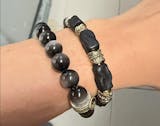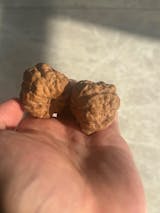Discovering the Beauty of Lacquer Fan:Make A Unique Artwork
What is a Lacquer Fan?
China’s intangible cultural heritage lacquer fan is a traditional handicraft made with lacquer-coated bamboo or wooden ribs and canvas, using natural lacquer to create unique patterns through splashing and staining. Its "painting with lacquer" technique leverages lacquer’s water resistance to form unpredictable yet intentional designs, making each fan a one-of-a-kind work of art. Beyond a cooling tool, it embodies thousands of years of cultural heritage.

Lacquer Fan and Lacquer: 8,000 Years of Oriental Wisdom
1. Lacquer: From Nature to Civilization
Lacquer, derived from the sap of the lacquer tree, is China’s unique natural resin coating. Mentioned in Shuowen Jiezi as "wood juice that can be coated like water droplets," it dries to form a durable, glossy finish. Historically used for ritual objects and burial coffins, lacquer became a symbol of imperial power and artistic excellence during the Tang and Ming-Qing dynasties, giving rise to techniques like carved lacquer and mother-of-pearl inlay.
2. The Evolution of Lacquer Fan’s Multiple Identities
- Imperial Regalia: Early lacquer fans served as ceremonial tools for emperors and nobles, symbolizing status.
- Scholarly Elegance: In the Song dynasty, literati transformed lacquer fans into desk ornaments, with poets like Su Shi praising their refinement.
- Folk Heritage: As craftsmanship spread, lacquer fans became everyday items in Jiangsu and Zhejiang, where workshops preserve the "slowcrafted" ethos.

Lacquer Fan Craftsmanship: Five Steps to Create Art
Materials:
- Blank fans (round, banana-leaf, or ruyi shapes)
- Colored lacquer (black, red, gold preferred)
- Tools: Water bucket (85%-90% full), mixing sticks, absorbent paper, decorative elements
Steps:
- Mix Lacquer: Shake the lacquer bottle upside-down to ensure even dispersion.
- Splash Base Color: Vertically dip the fan into water to create natural patterns.
- Add Details: Use brushes to paint flowers, clouds, or other motifs.
- Layer Decoration: Repeat dipping 2–3 times for depth; embed gold foil or pearls for texture.
- Final Touches: Dry thoroughly, then gently crack the surface for a " crazed" effect.
Tips:
- Reuse water after absorbing excess lacquer.
- Control humidity to delay drying for gradient effects.
- Modern innovations blend lacquer with 3D printing and AR technology.

Lacquer Fan’s Cultural Code: Material Expression of Oriental Aesthetics
1. Harmony with Nature
The random lacquer patterns reflect Daoist philosophy, mirroring landscapes painted by Guo Xi: "Mountains invite exploration, rivers offer repose."
2. Social Hierarchy
- Imperial Symbols: Ming Dynasty lacquer fans required decades to craft, exclusive to royalty.
- Scholarly Motifs: Literati engraved landscapes to express ideals.
- Folk Beliefs: Floral patterns on Suzhou fans symbolized good fortune.
3. Contemporary Revival
Lacquer fans now bridge tradition and global culture—Suzhou silk-screened fans were Winter Olympics souvenirs, while designers fuse lacquer art with minimalist aesthetics for luxury items. By embedding lacquer art into modern design languages, these fans transcend utility, becoming wearable symbols of cross-cultural storytelling.

Conclusion
A lacquer fan carries half a millennium of Chinese civilization. Through natural lacquer and masterful craftsmanship, it embodies harmony between humans and nature, social hierarchy, and timeless beauty. As the fan swings, it whispers not just coolness, but a cultural dialogue spanning eras.
Related articles:
Exploring Lacquer Art:History,Applications and Significance
How to Make A Lacquer Fan?A Guide for Beginners

























































